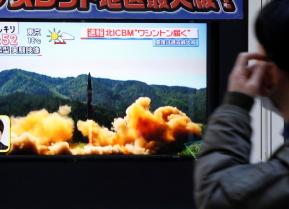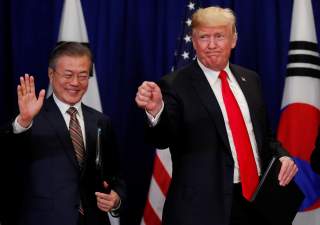North Korea and America’s Second Summit: Here’s What Christopher Lawrence Thinks Will Happen
"Maximalist up-front demands from the United States would risk further alienating one of its main regional allies."
Editor’s Note: Want more ideas on what will happen at the summit? Check out all 76 expert opinions we gathered here.
Donald Trump faces a steep challenge going into his second summit with Kim Jong-un. Most analysts agree that he is unlikely to eliminate North Korea’s entire nuclear program in the next two years. So he should instead look for tangible nuclear rollback steps during the remainder of his term, while not allowing those partial steps to be framed as the end goal of the process.
At least two plausible outcomes could emerge from this challenge. First, Trump might maintain that full denuclearization must precede any sanctions relief, and demand full nuclear declaration up front in exchange for written U.S. promises of a “prosperous future for North Korea.” But because U.S. commitments lack credibility in the regime’s eyes, it will likely reject this offer, and diplomacy may lose steam. U.S. analysts will then conclude that the regime’s diplomatic overtures were a ruse in the first place, but in truth we will have learned very little about its true intentions. And since South Korea envisions a phased reciprocal process toward nuclear rollback, maximalist up-front demands from the U.S. would risk further alienating one of its main regional allies.
Alternatively, Trump might explore Kim’s 2018 offer to verifiably dismantle the Yongbyon nuclear facility in exchange for “corresponding measures.” He could aim for dismantlement steps that are truly irreversible, such as pouring concrete into the core of Yongbyon’s 5-megawatt electric reactor where the North’s plutonium and tritium are produced. For “corresponding measures,” he may offer partial sanctions waivers—perhaps tailored to allow North and South Korea to begin rebuilding the North’s aging rail and energy infrastructures — to signal that the U.S. is serious about bringing North Korea out of isolation, while retaining significant sanctions leverage for later negotiations.
An interim deal focused on Yongbyon would leave North Korea’s clandestine enrichment program intact for the time being. But since the North would need continued tritium production to deploy high-yield long-range nuclear weapons in the future, willingly dismantling that capability at Yongbyon would imply that the regime’s long-term commitment to nuclear weapons may not be sacrosanct. Thus, following up on Kim’s offer could not only roll back North Korea’s nuclear program further than any previous U.S. policy to date, it could also give us new insight into the regime’s long-term nuclear plans.
The success or failure of the latter approach will depend on how serious Kim is about improving relations with the West. But if it were successful, an interim deal stipulating the right steps at Yongbyon would give Trump a big diplomatic win while adding credibility to the nuclear rollback process for future administrations to build on.
Christopher Lawrence is a physicist and a nuclear security scholar. He is currently a fellow at Harvard’s Kennedy School of Government, where he studies the history of U.S. engagement with North Korea.
Image: Reuters


